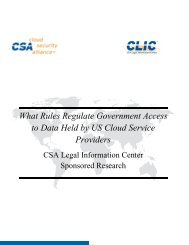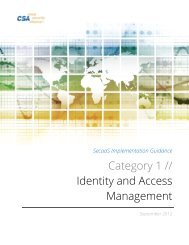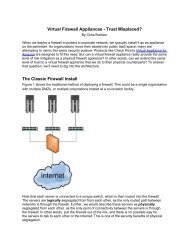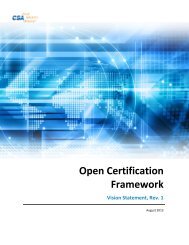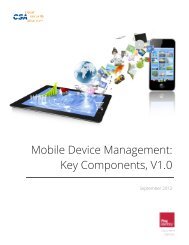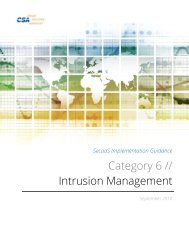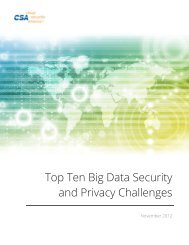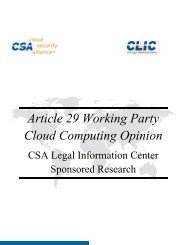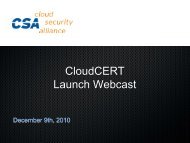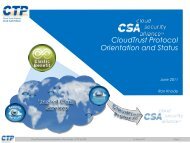Email Security Implementation Guidance - Cloud Security Alliance
Email Security Implementation Guidance - Cloud Security Alliance
Email Security Implementation Guidance - Cloud Security Alliance
- No tags were found...
You also want an ePaper? Increase the reach of your titles
YUMPU automatically turns print PDFs into web optimized ePapers that Google loves.
CLOUD SECURITY ALLIANCE SecaaS <strong>Implementation</strong> <strong>Guidance</strong>, Category 4: <strong>Email</strong> <strong>Security</strong>with a variety of other services to support different types of security functions, such as filtering or messageencryption.A key filtering sub-module is an antivirus filter. A common form of malware propagation is via email, so anantivirus filter is one of the first items to configure in the Mail Delivery Agent. When using a cloud-basedfiltering service, there are a number of key considerations.• Incoming mail should be transmitted to the service provider with a secure protocol such as TLS. Theprovider system will return results to the email system for it to act upon. Performance of the filteringservice will be affected by the speed of the connection, the connection latency and the capacity of theservice provider.• The use of a spam filter is similar to the antivirus filter. Limiting spam is an excellent way to increaseworkplace efficiency by reducing the amount of useless email arriving in the organization’s mailboxes.In addition, spam often will attempt to direct users to websites with malware.• Use of a cloud-based service provider is effective in reducing spam because the provider will see emailfrom multiple organizations and correlate spam messages across them in real time. The more often aspam filtering service sees a given set of spam emails, the more effective their heuristic algorithms willbecome, often in real-time as the spam propagation ramps-up.• Message and results traffic to the provider should be encrypted using TLS.• Performance will be affected by the speed of the connection, the connection latency and capacity of theservice provider.4.2.5 Mail Transfer AgentThe mail transfer agent is the mail system’s interface to the outside world. Receipt of external email uses MXrecords in the organization’s DNS configuration. Organizations typically will point their MX records to a serviceprovider system when either using a fully outsourced implementation or when using a service provider toprotect against denial of service (DoS) attacks. <strong>Cloud</strong>-based vendors can add capacity and filtering capability ondemandto react to changes in the threat landscape.It is common for enterprise hosted platforms to configure a vendor’s systems for spam and malware filtering astheir Mail Transfer Agent in front of their internal mail system. In this case, the MX records for the organizationwill refer to the vendor’s system. The service provider then receives all messages directly from outside partiesand can respond on-demand to increased spam, malware and DoS events with minimal effect on the internalmail system. Message that pass the filtering criteria are then passed onto the organization’s existing enterpriseemail system.4.2.6 Mail Storage<strong>Email</strong> messages may be or include key business correspondence and documentation. Proper care needs to begiven to their proper management. <strong>Email</strong> represents “data at rest” and needs to be properly protected. Whenusing a cloud email storage provider, this data at rest should be stored in encrypted form. The storage providerwill typically use a “multi-tenant” storage model, where data from multiple organizations are co-mingled on© Copyright 2012, <strong>Cloud</strong> <strong>Security</strong> <strong>Alliance</strong>. All rights reserved. 24




